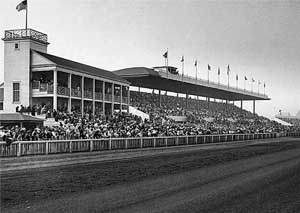On September 21, 1992, Longacres racetrack in Renton closes after 59 years. The final race is run without commentary, allowing a breathless record crowd of 23,258 to listen unimpeded to the pounding of the horses' hooves. Emotionally charged fans of thoroughbred racing, many in tears, flood out of the stands as the last race concludes and scoop up handfuls of the track's dirt for souvenir.
End of the Line
Longacres was founded in 1933 by Joseph Gottstein (1891-1971) and William Edris. Parimutuel betting on horseracing had been newly legalized in the state of Washington and Longacres became the first track to operate successfully under the new legislation. (Parimutuel betting is a system whereby the winners divide the total amount bet, after deducting management expenses, in proportion to the sums they have wagered individually.) Crowds of race fans anticipated the yearly meets at Longacres: the elegant grandstands designed by Marcus B. Priteca (1889-1971), the fast performance of the thoroughbred horses on the track's springy fine alluvial glacial till over clay track, the thrilling annual Longacres Mile race. Over the years the buildings were expanded and modernized. In 1963 Joseph Gottstein passed daily control of the track to his son-in-law Morris Alhadeff (1914-1994). In 1971, upon Gottstein's death, Alhadeff became president of Longacres. Alhadeff kept Longacres in pace with new developments in the horseracing scene, adding exotic wagering options including Exactas and a Pick Six.
In 1988 Alhadeff's sons Michael and Kenneth became track president and executive vice president, respectively. On November 27, 1990, beset by loss of revenue following six years of competition with the state lottery and despite attempts to make the track more appealing to families with children, the Alhadeffs announced that they had sold the track to the Boeing Company. The former farmland on which the race facilities lay had become more valuable than the revenue that seasonal-operated Longacres could produce. Boeing permitted the non-profit Emerald Racing Association to operate the track rent-free for two more years.
Fans on the final day of live racing at Longacres were admitted free of charge. Many were old fans for whom the Longacres experience was second nature. Others in the crowded stands were visiting the track for the first time, marking the moment when a local tradition passed into history. The Seattle Post-Intelligencer's Lenny Anderson reported, "From the Gazebo at the north turn to the Paddock Club on the south, the track was wall-to-wall people." The betting lines were window-to-window money ... the state-wide handle, which also includes wagering at 14 satellite locations, was on the way to a track record $3 million ... there were newcomers who didn't know a daily double from a jolt of scotch and long-timers such as Joe Wenzl, who has been playing the ponies since the 1940s (September 22, 1922). Many in the crowd were part of the Longacres "family": scores of track workers, ticket sellers, hot walkers, trainers, and jockeys who (with the horses) enabled everything. Many had generational associations extending back to Longacres' earliest days, and for these the loss of the track was a personal threat to both lifestyle and livelihood.
The program began at 3 p.m. The top featured races were the $150,000-added Belle Roberts Handicap and the $40,000-added Washington Championship. The weather was perfect, sunny with a light breeze. Above the stands an airplane hired by the Emerald Racing Association towed a sign printed with the message, Longacres fans, thank you. Between the fifth and sixth race the track's call-to-race trumpeter Dennis Schreffler played "Thanks for the Memories." Before the 11th race Schreffler's musical choices were "Taps" and "Auld Lang Syne." The final race was preceded by a post parade in which outrider J. D. Taylor carried the American flag to almost unending applause.
For the first time in Longacres' history, the final race was run without commentary. Native Rustler, under champion jockey Gary Stevens, won the final race. As the horse crossed the finish line Stevens turned toward the crowd and smiled and waved. Some fans scrambled over the outside rail and poured onto the tracks, gathering track dirt for souvenirs and wandering onto the grass infield. Finally, reluctantly, they were cleared from the grounds.
Over the next year the Longacres buildings -- grandstands, barns, clubhouse, jockey building, Paddock Club, carpenter's shop, mechanic's shop, Joseph Gottstein's cottage behind the toteboard, and the starting gate shed --- were photographed for the Historic American Buildings Survey. By early 1995, the buildings at Longacres had been demolished.

